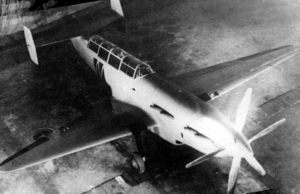Bolkhovitinov S
The Bolkhovitinov S (Sparka – twin/joined (engine)) was a high speed bomber aircraft designed and built in the USSR from early in 1937. Other designations used at various times: BBS, BB, LB-S or SSS.
| Bolkhovitinov S | |
|---|---|
 | |
| Role | High-Speed Bomber |
| National origin | USSR |
| Designer | Viktor Fedorovich Bolkhovitinov |
| First flight | 29 January 1940 |
| Number built | 2 |
Development
The plane was conceived as a fast light bomber and reconnaissance plane. To obtain high speed and good aerodynamics, it was powered by two M-103 inline engines in tandem in a fuselage nose, driving two contra-rotating coaxial three-blade propellers. The design had quite unusual look, with long fuselage nose and a crew cab moved rearwards, towards double tailfin. Wings had a fighter-like form and their span was rather short. The VVIA under Bolkhovitinov was enlarged to tackle the expected problems in the design of the Bolkhovitnov S. The rear engine was geared to two high-speed shafts which passed either side of the forward engine to drive the rear propeller gearbox, whilst the forward engine and gearbox drove the forward propeller via shaft through the middle of the rear propeller gearbox. The structure of the S was predominantly light alloy stressed skin, the wing having two spars with heavy flush-rivetted upper and lower skins, and the fuselage built up from pre-formed upper, lower, and side panels attached to four longerons to give a strong but relatively simple structure to build. A total of 29 electrical actuators drove the Fowler Flaps, undercarriage, (rotating 90deg to lie flat in the wing), exit flap of the large common radiator duct, and many other services. The tail unit consisted of twin fins with rudders attached to the tips of the tailplane, variable geared elevators and separate servo and trim tabs on elevators, and rudders. Detail design of the aircraft began in 1937 and construction in July 1938. The first prototype S-1 was built in 1939, but it was made in order to evaluate an airframe only and therefore was powered by only one engine M-103. It was unarmed and fitted with a fixed skid landing gear. It first flew on January 29, 1940, with B.N. Kudrin at the controls.[1] A maximum speed was 400 km/h. The second prototype S-2 was powered by two engines and was armed with a single machinegun and bombs.[1] Four 100 kg bombs were carried vertically in a bay between pilot and a rear gunner-navigator, under a common canopy. Its state testing started from March 20, 1940, and lasted until July 1940.[1] A maximum speed reached was 570 km/h (354 mph). The plane had good handling, except for take-off and landing, which were difficult due to high wing loading.[1] Its range and speed were also lower than estimated. As a result, it was decided to improve the plane further. However, the plane was not developed in a favour of next Bolkhovitinov designs.[1]
It was first planned to build also an attack plane with 2 Ultra-ShKAS machine guns with a high rate of fire, in a rear part of fuselage, firing downwards and manned by a second crew member. Also an interceptor aircraft was proposed, armed with 37 mm recoilless rifle, firing upwards at an angle and manned by two crewmen.[1]
The plane had no official designation given. It was mostly known as S - sparka (otherwise explained as spartak, skorost (speed) or Stalin), also known as BBS - blizhniy bombardovshchik skorostnoi (close-range fast bomber), BB - bombardovshchik Bolkhovitinova, LB-S - legkiy bombardovshchik sparka (light bomber paired), SSS - svyerkhskorostnoi samolet (very fast aircraft).[1]
Variants
- Bolkhovitinov I – A.M. Isayev was the lead designer of this experimental fighter/dive bomber based on a smaller 'S', with tandem M-107 engines envisaged for production aircraft and M-103 or M-105 engines for the prototype. Advanced features planned for the 'I' included Magnesium alloy (Elektron) structure, integral fuel tanks, tricycle undercarriage, and provision for catapult launching.
- Bolkhovitinov D – A projected heavy bomber with two tandem engine powerplants with a spindle-like fuselage with projecting gondola, mid wing and twin main wheels, wing area of 140m2, maximum weight of 28,000 kg (61,729 lb). A passenger variant was also planned but all work was abandoned at the start of hostilities with Germany in 1941.
Specifications (Bolkhovitinov S twin-engined)
Data from Gunston, Bill. “The Osprey Encyclopaedia of Russian Aircraft 1875–1995”. London, Osprey. 1995. ISBN 1-85532-405-9
General characteristics
- Crew: 2
- Length: 13.2 m (43 ft 4 in)
- Wingspan: 13.8 m (45 ft 3.3 in)
- Wing area: 26 m2 (280 sq ft)
- Gross weight: 5,652 kg (12,460 lb)
- Powerplant: 2 × Klimov M-103 , 715.9 kW (960 hp) each
Performance
- Maximum speed: 570 km/h (354 mph, 308 kn)
- Range: 700 km (435 mi, 378 nmi)
Armament
- 1 x 7.62mm ShKAS machine gun on a flexible mount in rear cockpit.
- Later 2 x 12.7mm UBT machine gun on a flexible mount in rear cockpit.
- 400 kg (882 lb) of bombs vertically stored in bomb bay between cockpits.
References
- Maslov, M.
- Gunston, Bill. “The Osprey Encyclopaedia of Russian Aircraft 1875–1995”. London, Osprey. 1995. ISBN 1-85532-405-9
- Taylor, Michael J.H. . “ Jane's Encyclopedia of Aviation. Studio Editions. London. 1989. ISBN 0-517-69186-8
- (in Russian) Maslov, Mikhail. "Krylatyi Spartak" in: Poligon No.2/2000
External links
| Wikimedia Commons has media related to Bolkhovitinov S. |